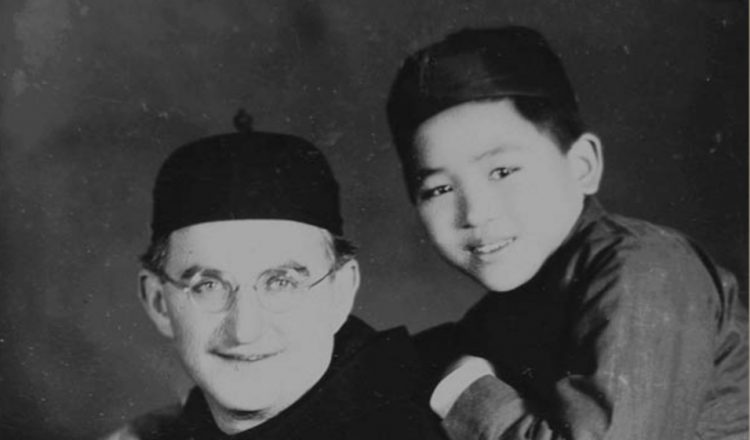
From a Chinese orphanage to the Eucharistic Congress of Budapest

A remarkable story has been silhouetted upon a photo and its origin. The research was started by Éva Schmelczer-Pohánka, Head of the Diocesan Library of Pécs, upon discovering in the Archives’ photo collection a picture that had been taken in the garden of the Episcopal Seminary of Pécs in the 1930s. It was a photo of a little Chinese boy standing in front of the St. Thomas Apostle statue by Michael-Bartalits. Moreover, another photo on the boy, in the company of a Franciscan friar, was also published by the February 17, 1938 issue of the newspaper “Magyarság”, in the illustration section that of. But who was this mysterious boy, and what kind of a life path had led him to Hungary?
The messenger of the Land of Smiles
To puzzle out the story itself, the research had to go back to the 1920s, namely to the Franciscan friar, Bernát P. Károlyi, back then being a student at Pécs, and who later on applied for a voluntary missionary position to China as from 1929. There in China, Father Bernát had set up a school, a hospital and an orphanage hosting and caring of 160 orphans, on top he even edited a Chinese-Hungarian dictionary. Accompanied by Siao Thomas, the boy on the photograph, Father Bernát returned to Hungary in 1938 to get some medical treatment. This little Chinese boy had been described by the people of the times, who had ever met him, as: “He is alive like a lizard…a finger in every pie. He imitates every word he hears like a jay…” “Tomi is all about soul! What a finesse and intelligence! The Hungarian words and songs are already over his lips. He greets the local boys in Hungarian, his small hands shaking theirs with a “servus”. Everything around him becomes the Land of Smiles in no minute time. When he is praying: it’s the radiation of the Saints’ spirit…As if he had always been ours. Everyone is familiar to him. At the post office he is the one saying: hello, this is the centre speaking. A kid, who loves everyone around him. Little Tomi, you as one of the small wheat grains of the gospel, you have remained here in our soul! With you, with your beautiful soul, with your radiating face, it is so easy to become God’s singers.”
His mother was beaten to death, his father died on the front
At that time a Chinese boy’s stay in Hungary was quite a sensation. He regularly appeared in the papers as well. Éva Schmelczer-Pohánka, in her research has gathered many information on the friar’s protégé: Siao Thomas was born on December 16, 1928 in China, in a small village, 30 kilometres away from Paoking. He had lost his parents during the 1927- 1937 Chinese civil war. His non-commissioned officer father died in 1931 on the front, while her mother was beaten to death in 1935 by the red- communist marauding bands. That was the time when little Siao was living first with his uncle, a catechist, later on was spending most of his life in a Franciscan missionary orphanage. Here, in the mission colony he met the Hungarian Franciscan missionary, Bernát Károlyi, and was baptized as well.

He and Father Bernát arrived to Hungary at the beginning of 1938. At first they feared that his little body would not be able to tolerate the local climate of Hungary. They moved to the Franciscan monastery, located at the Margit boulevard, later on they were discovering the entire country. In the year of the International Eucharistic Congress, at one of the Congress event, namely at the mission ceremony, hosted by the National Theatre of Pécs, the poem of the priest-poet, László Kocsis had been performed by Siao Tomi. Further on Tomi was singing then presented the beauties of the Chinese language. He even prayed the “Pater Noster” and the “Ave Maria” in Chinese. The full income of that gala event had been offered to the Hungarian missionary school in Paoking. Siao Tomi attended other events of the Budapest World Meeting, and was nicknamed by the then press as “the little Asian flower of the Eucharistic Congress.”
As a monk in the revolution
Tomi was an easy learner, he progressed extremely fast with his studies in Hungary. At the spring of 1939 in Vác, he managed to finish 3 Primary Classes within a single year. In 1941 he could already start with the public school, where he soon became a Scout leader, he bred caterpillars and rabbits, collected stamps, and was a fan of riding a bicycle. He was a collector of scrap metals. As for sports, he was excellent in athletics, was a terrific swimmer and an ice-skater. In 1943 he planned to begin his studies at a technology school in Budapest, afterwards to return to China as an expert in mechanical engineering. As to some available biographical data, on September 20, 1947 he professed his monastic vows at the St. John of Capistrano Franciscan order. He spent his novice years (1947-49) in the convents of Szécsény and Gyöngyös, where he got his monastic name: Norbertus Thomas Siao. He also studied humanities and theology.
Tomi’s friend, dr. Félix Frajka Franciscan father’s reflections ensured a great help to Éva Schmelczer-Pohánka for gathering more information on the life of the adult Tomi. After the dissolution of the monastic orders in 1950, he remained an order member. In October 1956, as a monk, he participated in the revolutionary events of Budapest: He joined the procession from the Bem statue up to the Parliament building. Following the suppression of the Hungarian Revolution he migrated to America, where he married Bernát Károlyi’s niece. They had two sons, one of them –not by surprise- has been named Bernard, the English version of Bernát. Siao Thomas passed away in 1987 in the United States.
Source: Diocesan of Pécs/Éva Schmelczer-Pohánka
Photo: Archives’ photo collection of the Diocesan Library of Pécs, Arcanum
Digital Encyclopedia










